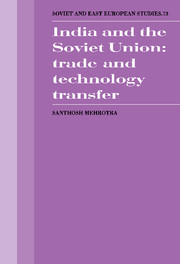Book contents
- Frontmatter
- Contents
- List of tables
- Preface
- List of abbreviations
- Introduction
- PART I
- 1 The Indian development strategy and the USSR
- 2 Indo-Soviet economic relations: geo-political and ideological factors
- 3 Soviet economic interests in non-socialist LDCs
- PART II
- PART III
- Notes
- Bibliography
- Index
- Soviet and East European Studies
3 - Soviet economic interests in non-socialist LDCs
from PART I
Published online by Cambridge University Press: 04 August 2010
- Frontmatter
- Contents
- List of tables
- Preface
- List of abbreviations
- Introduction
- PART I
- 1 The Indian development strategy and the USSR
- 2 Indo-Soviet economic relations: geo-political and ideological factors
- 3 Soviet economic interests in non-socialist LDCs
- PART II
- PART III
- Notes
- Bibliography
- Index
- Soviet and East European Studies
Summary
In order to develop a political economy of Soviet foreign economic relations, especially its relations with LDCs, it is necessary to examine how the domestic needs of the Soviet economy are reflected in its foreign economic relations. This chapter attempts to explain the expansion of Soviet economic relations with LDCs in the 1970s in terms of the compulsions that derive from the specific manner in which the Soviet economy has evolved over the past half-century.
Although the share of Soviet foreign trade as a percentage of its GDP is relatively small (not surprising for such a large economy with major resource endowments), Soviet participation in the international division of labour has expanded rapidly since the late sixties. Thus, while in 1960, three-quarters of all Soviet trade was conducted with other CPEs, within twenty years the share of DMEs and LDCs together in Soviet trade had grown to nearly 50 per cent. At the same time, Soviet economists keep emphasising that although the Soviet (and CMEA) share in world production has expanded enormously, its share in world trade is still very small – hence even now there is enormous scope for expansion. The compulsion to expand is not ‘capitalist’ (as argued by certain Marxists) but arises from other sources. In section 1 we discuss the domestic economic factors underlying this expansion of Soviet-DME and Soviet-LDC relations in the 1970s and 1980s.
- Type
- Chapter
- Information
- India and the Soviet UnionTrade and Technology Transfer, pp. 29 - 60Publisher: Cambridge University PressPrint publication year: 1991



